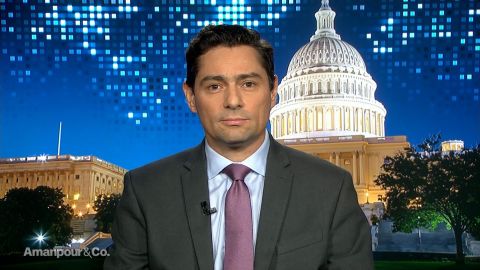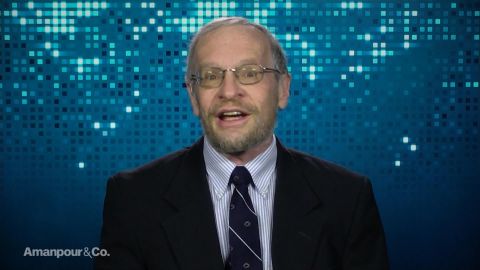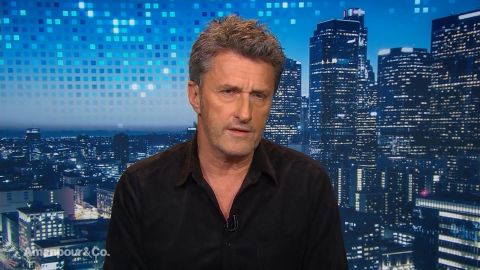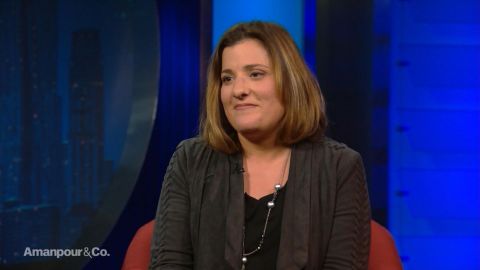Read Transcript EXPAND
CHRISTIANE AMANPOUR: And now for our final report tonight, we explore the price tag of a college education in the United States, rising debts, low wages, and increasing living expenses are forcing students to sacrifice the most basic necessity which is food. And it is an incredible situation. According to a new report by the U.S. Government Accountability Office, it says a third of students don’t have enough to eat. Sara Goldrick-Rab sees this in her classroom every day. She’s author of “Paying The Price” and she’s Professor of Higher Education Policy at Temple University in Philadelphia. She tells our Hari strain of Boston that it’s become an economic emergency as far too many ends up with plenty of debt but no degree.
HARI SREENIVASAN: Are people having to make the choice between eating and continuous school?
SARA GOLDRICK-RAB, PROFESSOR OF HIGHER EDUCATION POLICY, TEMPLE UNIVERSITY: They absolutely are. There’s really no question. We’ve done so many interviews with some of my colleagues over the many years now and we’ve seen students make those choices all the time. I will see students who will say, “You know, I’m so short on money, that in order to buy my books this semester, it means I’m going to miss rent payments.” I mean we estimate that almost 1 in 10 of American college students has been homeless in the last year. This is very serious and very common. It can mean that a student, for example, has a medical need and, therefore, does not have groceries for the month. There are so many competing pressures facing these students every day, some of which, you know, ordinary Americans are also very acquainted with. But it means that they’re going to have to give up on their education and leaving it partly unfinished where they leave in debt with no degree. It’s really consequential.
SREENIVASAN: And this gets almost personal for you. I remember you telling someone about one of your own students reaching out to you and telling you what she considered a secret.
GOLDRICK-RAB: Yes. I mean I have had students for a long time who have had these challenges. But I was especially taken when I first arrived at Temple University and an undergraduate came walking into my office. I thought she was there to ask for an internship. I mean she looked like, you know, very sort of put together, very bright, a science major. And she said to me, “I really need to tell you something.” And I said, what do you need to tell me? It’s the first time that we’ve met. And she said, “I hear that you know, that you understand that there are things going on that we don’t talk about.” And I said, what do you need to tell me? And she said, “I don’t have enough money for food.” And she said, “And I’m so embarrassed to say this but I’ve actually started shoplifting at the local grocery store so that I can get enough to eat.” And she said, “And I was recently caught and that means that I can’t do it anymore.” And she said, “So I don’t know where to get food.” And to be really frank with you, the woman sitting across from me was a white woman who looked very middle-class and, in fact, is middle-class. She is the child of people who value education, who have worked very hard to pay for college but who have struggled economically with a lot of ups and downs. And as they helped her go through college, they started to run out of money. She’s too rich to get financial aid and too poor to be able to actually afford college. And so she really found herself without enough to eat and very few options.
SREENIVASAN: That points to a whole group of people that seems to be missing from what little data that we do have, right. There’s a gap in our perceptions of who might be impacted by this and who actually is impacted.
GOLDRICK-RAB: That’s right. I mean we do tend to think about low-income college students when we think about this issue and when we think about financial aid generally. And that is important. I mean today’s Pell Grant recipients are absolutely being left short in ways that are unconscionable but there is a missing middle too. And it’s this middle-class that almost 50 percent of Americans believe they’re part of. But the middle class is not doing well. They’re strapped. They’re facing a lot of economic volatility. Work is not paying the way that they would like it to and college prices are often beyond reach. And so they might think they have it together and they get to college. And then again, they run short and they are mystified and frankly, a bit stigmatized, you know, when it comes to axing — asking for accessing this help.
SREENIVASAN: Give me a scale of the problem. How significant is food security for college students across the country?
GOLDRICK-RAB: Well, the first thing, and the GAO does emphasize this, is that we don’t actually really know at a national level because the federal government has never collected data on this in any systematic way. In fact, colleges and universities are also not required to collect data on this. So what we really know comes from surveys that we’ve done, one college at a time across the country. And myself and my team, as well as other researchers, around the country have amassed a large number of colleges over time in most states where we have done these surveys. And the results seem to suggest that around 40 to maybe even 50 percent of the nation’s college students are enduring food insecurity while they’re in school.
SREENIVASAN: Our general definition of who is a college student in America seems to be completely different, at least our perception of it, versus what the reality is.
GOLDRICK-RAB: There is a big disjuncture. We continue to think of college students as young people from reasonably wealthy families who value education and have sent their children off to college with savings in the bank, send them to live in residence halls and to focus on their schooling, pursue one or two majors, attend lectures and extracurricular events, and have a basically good time. Only 13 percent of American undergraduates these days live on a college campus. One in four has a child. Almost more than a third actually are over the age of 24. They don’t look the way we think they look and they don’t get the support that we popularly believe they get.
SREENIVASAN: If a third of students are going hungry, how is it possible that the price of tuition keeps going up?
GOLDRICK-RAB: These things are not entirely connected. The price of tuition rising is being driven primarily because states have changed what they’re paying for higher ed. So in the past, if — let’s say college was — cost a dollar. A state might say to a student, “We’ll put in $0.75, you’ll pay $0.25.” And over time, the state has begun to say, “We’ll pay $0.50, you pay $50.00” or even, “We’ll pay a quarter, you pay $75.00.” But the food issue is really, in many ways, also being driven by the increase of living costs in this country. So the fact is that you know, as housing has gotten more expensive that it’s created other pressures on food.
SREENIVASAN: So how schools deal with this idea of kids who are in their classrooms, or not even kids, adults in their classrooms, there I am falling back into the trap, who can’t figure out where their next meal is coming from?
GOLDRICK-RAB: What has changed over time is that we’ve drawn more attention to the structural factors that are creating this problem. At such a large number of colleges that no one college could be doing something wrong that would be causing this themselves. And as that’s happened, it’s enabled some colleges to be able to take more steps. So we see a growing number of campus food pantries. That’s at least a charitable impulse that’s being realized. We’re seeing a growing number, especially at community colleges, that are starting to help students access the SNAP program which is food stamps. We’re seeing some that are trying out programs like food scholarships. We’re also seeing some that are subsidizing some of those bigger expenses like housing. You know one of the reasons people don’t have money for food is that they can’t pay their rent. And so, for example, my team’s been working with a couple of housing authorities in this country that are working to offer more support to the people who live in public housing while they’re in college, so that they can actually really live and eat and go to college and then, frankly, get out of public housing, become economically self-sufficient.
SREENIVASAN: Because they’re not eating, they’re not studying well, they’re not performing well, they’re not likely to graduate.
GOLDRICK-RAB: They’re not. And, you know, this is such common sense. I mean there isn’t a teacher in this country who’s teaching an 8 or 9-year-old who thinks that if that child hasn’t eaten, they’re going to be active and engaged in the classroom. And we have no reason to believe that a 25-year-old or an 18-year-old would be any different.
SREENIVASAN: So you and your team have been looking at this for years now. You had a book out a few years ago. You were following 3,000 different students. I want to look at the longer arc here. Are things getting better or worse?
GOLDRICK-RAB: Part of the reason that it’s really hard for me to say is that we really were not tracking these issues in this way for any long period of time. I followed a cohort, you know, of these 3,000 students over time. And what I can tell you is that what it looks like for a student in their first semester of college can be very different than what it looks like for the 3rd or 4th or 5th semesters. There’s a lot of volatility and fluctuation. But are we worse off in 2019 than we were, say in 2017 or in 2012 or in 1982? We don’t know because these issues were not being examined. Because we’re looking now, I think over time we’re going to be able to say hopefully whether things are getting better or worse. But what I can tell you is that it is clear that higher education is getting in the public sector less resources per student than it ever has. We have more students from families with significant economic needs. And we have students who are having a harder time getting work that pays during college and enough access to financial aid to make up for those financial needs. So the crisis really, frankly, should still be here.
SREENIVASAN: If it’s under-resourced like this, is that driving part of what the student loan debt size has ballooned to? Give us some perspective of how big that is now.
GOLDRICK-RAB: You know the student loan debt overall size to me matters a little bit less frankly than the number of borrowers who are unable to repay their loans. And those people, really interestingly, are not the ones who have the big debt. Not what we would call big. They have like $5000 of debt. The problem is they only got like a year of college education. So these are high school graduates walking around with the feeling of having dropped out of college and now owing loans. They have no economic ability to repay. Many of them are taking loans they should never have had to take. They were Pell Grant recipients in college which when that program began meant that nobody should take a loan. We never intended for people who were low income when they come to college to have to take debt. They were supposed to get a grant. The Pell program now covers barely a third of public colleges and universities total costs.
SREENIVASAN: And that’s different than when it that started out.
GOLDRICK-RAB: Exactly. It’s a major decline. It was supposed to cover a hundred percent. We’re down to a third. It’s — I mean if they’re going to be in college, they’ve got to take on the debt but their chances of finishing are not that high. So they come out with debt and no degree. And now they’re in potentially even a worse situation than they were in the first place before they went to college.
SREENIVASAN: Also, I was going to say [13:50:00] look, what about Work- Study? I had to have a job and go to school or we can have people work 15, 20 hours to qualify for benefits.
GOLDRICK-RAB: Yes. It’s a great idea. So the problem is that Work-Study in this country is so incredibly underfunded. That as more people have needed it over time, we have not increased the support for it. As a result, only about 1 in 10 Pell Grant recipients, these low-income students in public colleges or universities, are getting supported by the Work-Study Program. And, unfortunately, when we’ve pointed that out and noted that Work-Study is immensely popular, it aligns with what people think should happen. You should work in college and work on campus. Instead of that, this administration has actually tried to get rid of the Work-Study Program rather than to grow it to meet the need.
SREENIVASAN: Are we approaching it slightly in a different way? Are we overvaluing college? Meaning is college right for everyone?
GOLDRICK-RAB: Look, I don’t think to say that college should be affordable and accessible for everyone is to say everyone has to go to college. Those are two really different things. But I think that one of the problems we have, college has become the place America loves to hate. Partly because America thinks that what everybody is doing in college is pursuing a degree of some sort they don’t find valuable. What they don’t seem to realize is that a lot of the services that they now seek are performed by people who do have to get some sort of occasional or technical training and that training is offered in college. Community colleges and universities around the country are the places that people who do all sorts of things, everything from cosmetology to truck driver training, they do these things in college. Now, colleges are the places they go to get them. So to say that college is unaffordable is not just to say, well, you can’t get that philosophy degree. It’s also to say you can’t get the credential you need to be an automotive technician. What kind of situation are we going to be in when we say, no, let’s cut people off from those occupations?
SREENIVASAN: When you look at this from the 30,000-foot view, I mean higher education was supposed to be this opportunity to move social mobility, move class, right. So it was — community college infrastructure was supposed to be that alternate path. What’s happened to our idea of what college is capable of doing especially at a time where it seems that we’re all socially asking for that credential?
GOLDRICK-RAB: Yes. So I think that the fact is that the idea, the theory is right, education can do all the things you just described and it did do it in the 20th century. Many of the things we all enjoy today, whether it’s our iPhones or the innovations that we have on the Internet, were created by the expansion of education. Education propels innovation. But the problem is that we never really actually all agreed to this at the policy level. And so while we, some of us, set out to make policies to expand educational opportunity and higher education, the fact is that states really never did join in a full way the federal government in making college truly affordable. And over time, depending on the administration in charge in Washington, they have undermined the financing behind the idea. So the idea has stood. The idea has been widely heard by the public which has said, yes, we want college. But we did not build and sustain a financing system to actually back up that idea. And I think that’s the task of the 21st Century. It’s time to figure out how to live up to the promise, how to get together and understand that this is not a mushy social justice issue. This is an economic issue. We’re either going to have to rebuild a lot of social programs to support people who can’t get a job, are living in poverty, are going to have high medical expenses, are going to be “on the dole.” Or we can give them a viable path to economic self-sufficiency, which we know runs through education. Seems like the latter is probably the more cost-effective thing to do and it’s what each individual person is choosing for their children. The question right now is what they’re going to choose for other people’s children.
SREENIVASAN: Thanks for joining us.
GOLDRICK-RAB: Thanks for having me.
About This Episode EXPAND
Christiane Amanpour speaks with Carlos Vecchio to discuss the struggle for democracy in Venezuela; CNN Correspondent Ryan Young and climate scientist Richard Alley about the extreme temperatures in the Midwest; and director Pawel Pawlikowski about his new film “Cold War.” Hari Sreenivasan speaks with Sociology Professor Sara Goldrick-Rab about the struggles students face.
LEARN MORE



